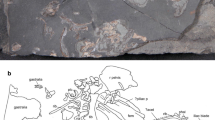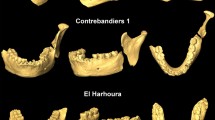Abstract
IN a recent article1 a hominid terminal toe phalanx was described (Olduvai Hominid 10). The bone was recovered from site FLK North (FLK N1), Upper Bed I, Olduvai Gorge, Tanzania. In that article morphological evidence was put forward to support the view that the bone belonged to an upright hominid with a plantigrade propulsive or striding gait. Further studies on the toe bone, and comparative series of toe bones, have included calculation of the D2 generalized distance coefficient of Mahalanobis and canonical variate analysis. The results entirely confirm the previous morphological assessment.
This is a preview of subscription content, access via your institution
Access options
Subscribe to this journal
Receive 51 print issues and online access
$199.00 per year
only $3.90 per issue
Buy this article
- Purchase on Springer Link
- Instant access to full article PDF
Prices may be subject to local taxes which are calculated during checkout
Similar content being viewed by others
References
Day, M. H., and Napier, J. R., Nature, 211, 929 (1966).
Clarke, M. R. B., and Maxwell, A. E., Program Specification PS 17 EXCHLF SSP 1 (Univ. London Inst. Computer Sci., 1966).
Author information
Authors and Affiliations
Rights and permissions
About this article
Cite this article
DAY, M. Olduvai Hominid 10: a Multivariate Analsis. Nature 215, 323–324 (1967). https://doi.org/10.1038/215323a0
Received:
Issue Date:
DOI: https://doi.org/10.1038/215323a0
This article is cited by
-
Fossils and concepts in hominid paleontology: The W. C. O. Hill memorial lecture
International Journal of Primatology (1981)
-
Laetoli Pliocene hominid footprints and bipedalism
Nature (1980)
-
Multivariate Analysis of the Dryopithecus africanus Forelimb
Nature (1973)
Comments
By submitting a comment you agree to abide by our Terms and Community Guidelines. If you find something abusive or that does not comply with our terms or guidelines please flag it as inappropriate.



